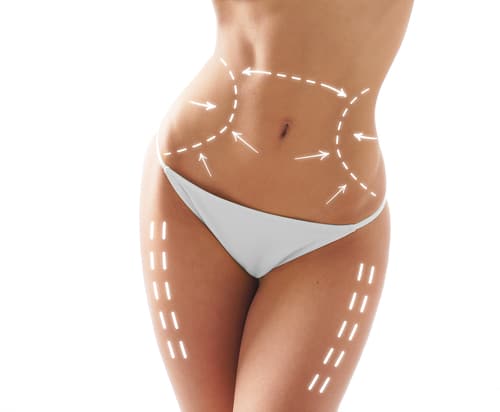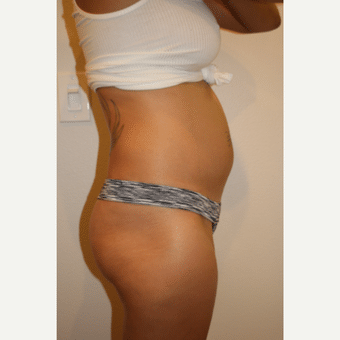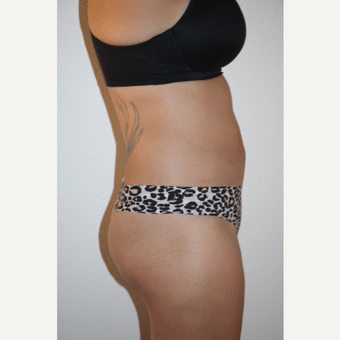
Despite diet and exercise, do you have an area of your body that never takes shape or size like the other areas of your body? Do “saddle bags,” “love-handles” or a lower belly pooch interfere with the proper fit and look of your clothes? Liposuction, also known as lipoplasty, liposculpture or simply lipo ("suction-assisted fat removal") is a cosmetic surgery operation that removes fat from many different sites on the human body. Areas affected can range from the abdomen, thighs and buttocks, to the neck, backs of the arms and elsewhere.
Liposuction is the second most commonly performed cosmetic surgical procedure in the United States. Modern techniques have made liposculpture a typically safe and reliable method for removing stubborn fat deposits and providing better contours to the human figure.
Liposuction
Liposuction is the second most commonly performed cosmetic surgical procedure in the United States.
If you desire better contours and curves then liposuction may be right for you. Learn more with our Frequently Asked Questions and Answers below.
FAQs About Liposuction
Liposuction is a surgical procedure designed and implemented to remove fat from designated areas of the body.Liposuction slims and reshapes specific areas of the body improving your figure and proportion, and ultimately, enhancing your self-image. Liposuction is a body sculpting surgery.Ideal candidates for liposuction are people who eat well and are of essentially normal weight with stubborn fatty deposits such as the flanks (love handles) or outer thighs (saddle bags).Genetically abnormal collections of fat are called “lipodystrophy”(abnormal distribution of fat).Liposuction is the process of carefully extracting this fat by using thin hollow tubes called cannulas.Liposuction surgery is not a treatment for obesity and is not a replacement for regular exercise and good eating habits.
Liposuction is performed by first infiltrating the target area with a dilute lidocaine and epinephrine anesthetic solution (tumescence).This tumescent solution allows for comfortable removal of the fat with little blood loss.After the tumescence has been placed, the fat is skillfully removed using thin hollow tubes called cannulas.For improved results many cases involve the use of an additional device prior to the removal (suction) of the fat.In my practice, internal ultrasonic assisted liposuction (UAL), namely VASER, has demonstrated dramatic advantages over suction assisted liposuction (SAL) alone for certain areas of the body.
Despite good health and a reasonable level of fitness, some people may still have a body with disproportionate contours due to localized fat deposits.These areas may be due to family traits rather than a lack of weight control or fitness.Liposuction surgery is performed to treat stubborn fat pockets in many parts of the body including the neck, arms, chest, abdomen, hips, flanks, thighs, back and knees.The typical result is a body with better overall proportion and symmetry.
Tumescent liposuction designates a form of liposuction that uses tumescent local anesthesia.The tumescent technique involves the injection of large volumes of very dilute lidocaine (local anesthetic) and epinephrine (medicine that shrinks small blood vessels) into subcutaneous fat.The word tumescent means swollen and firm. The local anesthetic lidocaine in the tumescent solution provides such complete local anesthesia, that it eliminates the need for general anesthesia, or IV sedation.With the tumescent technique, the volume of dilute lidocaine that is injected into fat is so large that the targeted areas literally become tumescent (swollen and firm).The drug epinephrine (adrenalin) provides profound localized vasoconstriction that it virtually eliminates surgical bleeding during tumescent liposuction.By eliminating the risks of general anesthesia and the risks of excessive surgical bleeding, the tumescent technique for liposuction by local anesthesia has eliminated the greatest dangers associated with older forms of liposuction.
All forms of liposuction begin with the infiltration of a dilute lidocaine and epinephrine saline solution.The method of the subsequent fat treatment and removal is what differentiates various liposuction techniques.Suction-assisted liposuction is the standard method of liposuction. In this approach, a small cannula (like a straw) is inserted through a small incision. It is attached to a vacuum device. The surgeon pushes and pulls it in a forwards and backwards motion, carefully through the fat layers, breaking up the fat cells and drawing them out of the body by suction.Therefore, suction assisted liposuction is a two-step process.The first step is infiltrating the tumescent solution into the fat.The second step is removing the fat and residual tumescent solution by using variously sized cannulas.
All forms of liposuction begin with the infiltration of a dilute lidocaine and epinephrine saline solution.The method of the subsequent fat treatment and removal is what differentiates various liposuction techniques.In ultrasound-assisted or ultrasonic liposuction, a specialized cannula is used which transmits ultrasound vibrations within the body. This vibration bursts the walls of the fat cells, emulsifying the fat (i.e. liquefying it) and making it easier to suction out. UAL is a good choice for working on more fibrous areas, like the upper back, flanks or male chest. After ultrasonic liposuction, it is necessary to perform suction-assisted liposuction to remove the liquefied fat. Ultrasound-assisted liposuction techniques used in the 1980s and 1990s were associated with some cases of tissue damage, usually from excessive exposure to ultrasound energy.Third-generation UAL devices address this problem by using pulsed energy delivery and a specialized probe that allows physicians to safely remove the fat. Ultrasonic assisted liposuction is a three-step process.The first step is infiltrating the tumescent solution into the fat.The second step is liquefying the fat with the ultrasonic probe.The third step is removing the liquefied fat and residual tumescent solution by using variously sized hollow cannulas.
The VASER Lipo System is a third-generation ultrasonic assisted liposuction system.The VASER system represents a major advance in the application of ultrasonic technology to cosmetic procedures.The system is designed to preserve as much of the tissue matrix as possible, yet still remove the desired amount of fatty tissue.The VASER works by selectively emulsifying (liquefying) the fatty tissue prior to its removal.The VASER is best used for fibrous areas of the body including the back, male chest and upper abdomen.The VASER system and its proper use represent a major advance in body contouring surgery.
A good candidate for liposuction begins with the person being in good overall health.The heath of a prospective patient is a more important consideration than age or weight.In addition, having realistic expectations regarding the outcome is very important.The most ideal liposuction candidate is a person who eats well, is essentially normal weight but has stubborn fatty deposits such as in the flanks (love handles) or outer thighs (saddle bags).Overweight people may also be good candidates for liposuction when carefully selected.It is important to remember that liposuction is not a weight loss surgery.The weight of the fat removed from the surgery may only be 1-5 pounds. The best results from liposuction surgery are experienced in people with the greatest lipodystrophy (abnormal distribution of fat).
Liposuction is a completely elective and voluntary surgery.Patient safety is of utmost importance.Unhealthy individuals are at greater risk for suffering complications.Heart disease, diabetes, blood clotting disorders and other chronic illness involves greater risks and potential complications from any surgery.An obese individual almost always does not make a good liposuction candidate.Overweight individuals may be good candidates depending on certain variables including proposed site of liposuction, patient goals and expectations.Only rarely and in very carefully selected cases do obese individuals make acceptable liposuction candidates.In these cases it is usually only one area that the patient will benefit from fat removal.You will be disappointed if you expect liposuction to be an effective means to lose weight permanently.Liposuction is not proven to be an effective treatment for obesity.If your skin does not have good elasticity, then you might expect there to be some degree of a slightly wrinkled appearance.However in many cases, patients with poor skin elasticity are very happy with their new shape despite the slight wrinkled appearance of the skin.
The amount of time to complete a liposuction procedure is dependent on several variables including the number of areas to be sculpted and the pre-operative size of the area.In my hands, cases tend to take from 1-3 hours to complete.
It is important that you be sufficiently prepared for your postoperative recovery period.Complete written post-operative instructions will be provided prior to surgery.
Unless your procedure involves only a small area, do not plan on driving yourself home.Please make arrangements for transportation on the day of your procedure.The post-operative discomfort experienced from liposuction is typically mild and occasionally moderate.Swelling and soreness are expected consequences of liposuction.Two extra-strength Tylenol should be taken every 4-6 hours while awake for the first 48 hours to reduce postoperative soreness and swelling.Discomfort is worse the second day after surgery and then improves daily. Narcotic pain medication may be prescribed after your procedure however is usually not needed.Antibiotics will be prescribed and should be taken as directed until the prescription is finished.Take antibiotics with food.
A compressive garment will be placed at the finish of the surgery and is required to be worn for up to one month following the procedure.These garments are compressive and will fit under your normal clothing.You are permitted to remove the garment each day for showering.For the first 24-48 hours and sometimes longer, leakage will come from the small incisions made during the surgery.This leakage is normal and will stop.Bandages worn over the incisions are recommended during this initial leakage time.During the first 36 hours, when sitting or lying down, you should place absorbent towels beneath you in order to protect your furniture from any expected leak of blood-tinged drainage.When there is a large amount of drainage, it is advisable to place a plastic sheet beneath the towel.
If you have had liposuction totally by local anesthesia, you may resume your usual diet immediately.Drink adequate amounts of water, juice or sports drinks to prevent dehydration.Avoid drinking alcoholic beverages for 48 hours after surgery.Rest is recommended for the first few hours immediately after surgery.Do not drive; operate hazardous machinery for 24 hours after surgery.Later in the day or evening of surgery you may take a walk if desired.Walking will assist in the drainage process and reduce swelling and soreness.The day after liposuction surgery you should fell well enough to drive your car and engage in light to moderate physical activities.You may carefully resume exercise and vigorous physical physical activity 1 to 2 weeks after surgery.Most people can return to a desk job within one to two days after the procedure.
Showering is recommended on the first day after surgery.Keep incisions clean.First wash your hands, then wash incisions gently with soap and water; afterwards gently pat incisions dry with a clean towel. Apply new absorbent pads if drainage persists.When an incision has ceased draining for more than 24 hours, it no longer needs to be covered by pads.Removing the garment for the first time may cause lightheadedness so make sure to seek assistance if necessary.The garment should be washed once every day or two and allowed to air dry.The first follow-up appointment is either the first day after surgery or one week after surgery.Our office will instruct you on your follow-up appointments.
Do not apply ice packs or a heating pad to skin overlying the areas treated by liposuction.The area may be numb following the procedure and ice packs or heat may injure the skin.Bruising is minimal with tumescent liposuction.Nevertheless, the more extensive the liposuction surgery, the more bruising one can expect.Some patients have more of a tendency to bruise than others.Do not soak in a bath, Jacuzzi or swimming pool for at least 7 days after the surgery in order to minimize the risk of infection.
Dr. Mitchell is available 24 hours per day and can be reached on his cell phone for urgent questions or concerns.
Every surgical procedure has risks and potential complications.Although extremely rare, bleeding can occur following liposuction.Infection is possible.Perioperative antibiotics will be prescribed.Call our office if you notice signs of infection such as fever, foul-smelling discharge, or focal redness, swelling, or worsening pain in a treated area.Localized skin burns or abrasions, uneven contour or lumpiness have been reported.Every effort is made to create an even contour to the skin and immediate subcutaneous fat.Inelastic skin may be left with a loose or wrinkled texture following liposuction.More serious complications including deep vein thrombosis and internal injury have been reported in the medical literature however have not been encountered in Dr. Mitchell’s practice.An entire list of the risks and potential complications will be presented to you prior to your procedure.Your informed decision to undergo liposuction is required.Please do not hesitate to write down and ask questions at any time.
See these before and after images to get an idea of the success other patients have found with Dr. Mitchell and his team.
Before

After

Age Gracefully: The Benefits of Non-Surgical Anti-Aging Treatments
Aging is a natural process that brings wisdom and experience, but it also brings changes to our skin and appearance that many of us would like to manage gracefully. For those who prefer to avoid surgery, there are numerous non-invasive treatments available that can help maintain a youthful appearance. These treatments offer effective solutions with […]
Read MoreTestimonials
What People are Saying
Dr. Mitchell's patients love him and his team and are always incredibly happy with their results!
A skilled personable artist with integrity. I had Radiesse done on a few occassions with Dr. Mitchell with great results. He will recommend what he thinks will help the patient ...
Excellent doctor! Had Blepharoplasty done and he did an amazing job!! Perfect work. He is also very kind and takes his time to listen to your needs. He is also ...
Recently had liposuction done by Dr. Mitchell on a problem area in my mid section and I couldn't be more happy. The staff was great and the results are amazing. ...
